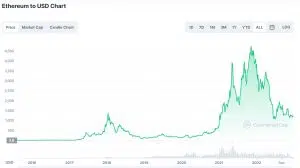The fall of 2022 saw the long-awaited upgrade to The Merge and the transition of the Ethereum network to the new Proof-of-Stake (PoS) consensus (read more about this here). This transition brought some rather unexpected consequences — many experts argue that dangerous centralization is growing in Ethereum, which threatens to censor the network. This review article shows the three main vectors of this increasing centralization.
Ethereum on the road to centralization
Centralization is growing in three vectors, which seem to increase the dangers of each other:
1. At the protocol level
At this point, Ethereum is already under the de facto control of the U.S. government, which censors the flow of transactions within the blockchain. Technically, this is implemented by a third party under the threat of sanctions.
The brand new newsletter with insights, market analysis and daily opportunities.
Let’s grow together!
According to Labrys, about 50% of blocks on the Ethereum network are rejected at the mining value extraction (MEV) protocol level. Flashbots censors all transactions, effectively implementing a de facto MITM attack against the network. According to this MEV-Boost monitoring, 71% of relays are enforced by USA OFAC compliance. This is an unexpected effect of the sanctions imposed on Tornado Cash.
There was a short downtrend in Ethereum MEV censorship, but sadly it seems to have reversed.
Of most interest actually is that both Lido and Rocketpool appear to be censoring a decent chunk of their transactions.
CEX stakers are unsurprisingly censoring.
Tough reality. pic.twitter.com/mNNqdCUs34
— _Checkmate 🟠🔑⚡☢️🛢️ (@_Checkmatey_) December 18, 2022
This problem has already been noted at the very top. Vitalik Buterin recently suggested a solution — a “partial block auction,” in which the block creator has the right to determine only part of the content. There were also other proposals to fight against censorship at the consensus level — Single Unifying Auctions for Value Expression (SUAVE). But so far these are only long-term plans and talks, while censorship is already actually working.
It’s well known that MEV extraction can accelerate network centralization and harm users through strategies such as front-running. This post compares a few of the approaches being taken to mitigate the impact of MEV in the Ethereum and Cosmos ecosystems.https://t.co/ZEmxNBeicX
— Myles O'Neil (@MylesOneil) December 26, 2022
2. At the hosting level
Because of the danger of Ethereum being recognized as a security after the transition to PoS (U.S. authorities have already made such threats), many hosting providers refuse to host Ethereum nodes in advance (U.S. law prohibits any involvement in the illegal trafficking of security assets).
The other side of the issue is that PoS architecture allows multiple validators on a single physical node, which will eventually lead to a reduction in the number of nodes, which can negatively impact network connectivity. More than 50% of the nodes are no longer classic PoW nodes; they are on AWS, a centralized resource. According to Santiment, about 50% of the nodes on the network (running after The Merge update) were managed by just two addresses. Earlier, Rocket Pool, a major validator of the Etherium 2.0 nodes, stated that the only way to resist a regulatory takeover of the Ethereum network after The Merge is to topologically and geographically decentralize the validators.
We will not explore this case in detail, as the situation is completely similar to Solana (we described it in detail here).
📊 According to our #Ethereum Post Merge Inflation dashboard, 46.15% of the #proofofstake nodes for storing data, processing transactions, and adding new #blockchain blocks can be attributed to just two addresses. This heavy dominance by these addresses is something to watch. pic.twitter.com/KQdFNgGloD
— Santiment (@santimentfeed) September 15, 2022
3. The possibility of a 51% attack
According to the latest data from Delphi Digital, 57% of all $ETH staked is handled by four stacking providers. Such enormous consolidation of resources gives potential opportunity to seize control over the network.
Decentralization of a PoS-based cryptocurrency is determined, among other things, by the number of holders of its digital coins. And if the network consists of four ultra-large players, that’s pretty sad. Earlier, the problems with Ethereum decentralization were pointed out by a large P2P platform Paxful, which acted quite radically in announcing the delisting of ETH.
57% of all $ETH staked is handled by 4 staking providers, with @LidoFinance alone representing 30%. pic.twitter.com/h5nKuIXDKb
— Delphi Digital (@Delphi_Digital) December 24, 2022
Midterm outcome
Increasing centralization creates a web of threats to the blockchain, from blockchain censorship to hacker attacks. In any case, it is already clear that the move to PoS has had adverse side effects, the consequences of which the community is only beginning to realize and analyze.
At the moment, Ethereum is already under the de facto control of the U.S. government. This means that all DeFi applications running on the Ethereum network are not decentralized, and blockchain transactions are not resistant to censorship.
How can I make money on this?
The long-awaited update to The Merge has not brought relief but has created new problems. If the problems described above are not solved, it is evident that Ethereum will have an unenviable fate. So far, it is obvious that those who stacked their ETH into Ethereum 2.0 were in a significant loss, which confirms the contradictory nature of the project’s development.
It might be worth catching the moment of the next negative news about Ethereum centralization (of which there will be plenty) to try to short this asset. As always, we also recommend being cautious during crypto winter, especially trying to make money on the asset’s downside.








